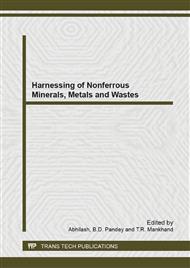p.1
p.11
p.21
p.33
p.45
p.55
p.65
p.73
Anodic Dissolution Behaviour of Tungsten Carbide Scraps in Ammoniacal Media
Abstract:
In the present paper, potentiodynamic studies of WC scrap have been carried out as these studies give better idea about the anodic dissolution behaviour of the scrap material to recover the metal values. However, it has been seen that anodic passivation retards the dissolution of the scrap and adversely affects the recovery of metals. To minimize the passivity and to increase the anodic dissolution, some chemicals are often used as additives. Two different electrolytes namely hydrochloric acid and aqueous ammonia at varying concentrations had been employed for the above studies. The additives citric acid and oxalic acid were added to the acidic electrolyte whereas ammonium chloride, ammonium carbonate and ammonium sulphate were added in different concentration to the ammoniacal electrolyte. The studies revealed that 2% citric acid in 1N HCl was the optimum to achieve maximum anodic dissolution (current) of WC scrap. On the other hand, 5% NH4Cl was found suitable to obtain maximum anodic dissolution (current) in the ammoniacal (150 g/L) medium. The potentiodynamic studies were followed by the actual electrodissolution experiments in an electrolytic cell with the help of a rectifier. The W and Co recoveries were encouraging.
Info:
Periodical:
Pages:
11-20
Citation:
Online since:
November 2013
Price:
Сopyright:
© 2014 Trans Tech Publications Ltd. All Rights Reserved
Share:
Citation:


